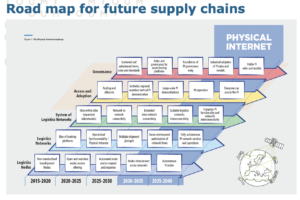In response to the Paris Agreement, more governments, associations, and businesses are setting bold climate targets. As set out in the European Green Deal, Europe aims to be the first climate-neutral continent by 2050. This will be achieved with a two-step approach designed to reduce CO2 emissions by 50%, if not 55%, by 2030.
The logistics sector should move to a paradigm where they can do more with less. In parallel to developing lower and zero-emission vehicles and low-emission energy, it is critical to leverage opportunities for increased logistics efficiency. Alice envisions essential benefits for all stakeholders by doing more with less in the freight and transport industry. The existing idle capacity of assets in all modes of transport and storage could be better utilized, and flows could be managed more broadly using and combining transport modes and other logistics assets smartly.
The Physical Internet Concept supports the implementation of the Zero Emissions Logistics 2050 Roadmap, which was delivered in 2019, and builds on the Truly Integrated Transport System for Sustainable and Efficient Logistics, which was delivered in 2016.
Roadmap
The publication of a roadmap concludes a journey that started at the International Physical Internet Conference in Groningen in 2018 and the publication of the Roadmap towards zero emissions logistics in 2019. As Alice decarbonized logistics as its primary objective, it was necessary to underline how the Physical internet was still central.
Physical Internet is now a core strategy to achieve the leading end: a logistics industry that enables a sustainable human ecosystem on Earth. So, while the industry badly needs research in new technologies built around sustainable energy sources, the actual innovative heavy lifting must be done now, relying mostly on current infrastructure and technological assets.
The roadmap has identified five main areas of development:
From Logistics Nodes to PI Nodes
In Logistics Nodes, goods are consumed, stored, transformed, or transhipped from one transport mode to another. Ports, airports, logistics hubs, terminals, distribution centers, warehouses, and depots are examples of Logistics Nodes. The Physical Internet envisions the development of the Logistics Nodes into Physical Internet nodes in which the operations are standardized, and using a family of standard and interoperable modular load units from maritime containers to smaller boxes is extensive. Services in PI nodes are visible, digitally accessible, and usable, including planning, booking, and execution operations.
From Logistics Networks to Physical Internet Networks
Logistics networks include logistics nodes and transportation services that connect the logistics nodes and reach the destination. Logistics Networks are controlled by a single company, either a shipper, a freight forwarder, or a logistics service provider reaching their value chain (i.e., customers and suppliers). PI Networks are expected to build seamless, flexible, and resilient door-to-door services consolidating and deconsolidating all shipments within a logistics network in which all assets, capabilities, and resources are seamlessly visible, accessible, and usable to make the most efficient possible use of them.
Developing the System of Logistics Networks towards the Physical Internet
The system includes interconnected individual logistics networks. Therefore, all logistics network owners can access the assets, services, and resources of the individual logistics networks. The System of Logistics Networks forms the backbone of the Physical Internet and requires secure, efficient, and extensible services to flow goods, information, and finances across logistics networks.
Access and Adoption
This area describes the main requirements for accessing the Physical Internet through a logistics network component. It also includes steps and the mind shift required to adopt Physical Internet concepts.
Governance
Governance includes the developments needed to evolve the Logistics Nodes, logistics networks, and the System of Logistics Networks into the Physical Internet, i.e., the rules defined by the stakeholders forming or using them, as well as the trust-building processes and mechanisms.
Source: Alice

